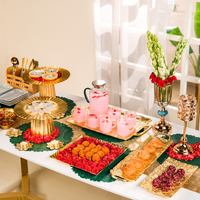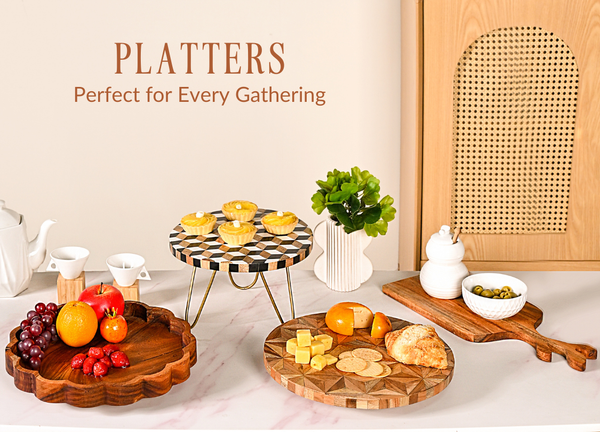Interior design is not merely about arranging furniture or picking out colour schemes - it's a reflection of our societal values, cultural shifts, and individual tastes across history. From the lavish palaces of ancient civilisations to the minimalist, technology-infused spaces of today, interior design has undergone a fascinating evolution. Let's embark on a journey through the ages to explore how interior design has transformed over millennia.
Visit: https://nestasia.in/collections/home-decor
Journey Of Interior Design Through History
1. Ancient Civilisations (3000 BC - 476 AD)
The origins of interior design can be traced back to ancient civilisations such as Mesopotamia, Egypt, Greece, and Rome, which are among the earliest examples of this art form. Palaces and temples of these civilisations were adorned with intricate carvings, vibrant murals, and luxurious furnishings, showcasing the wealth and power of rulers and deities. In these societies, architecture and interior design were closely intertwined, with spaces often designed to evoke a sense of awe and reverence.
In ancient Egypt, interior design mirrored cultural beliefs and rituals, showcasing the wealth and status of pharaohs and nobility through decorations and furnishings made of gold, ivory, and precious stones. Conversely, ancient Greek interior design emphasised simplicity and proportion to create harmony and balance. Greek homes often included painted murals, columns, and statues, with wooden furniture featuring intricate carvings.
Also visit: https://nestasia.in/collections/nest-luxe
2. Medieval And Renaissance (476 - 1600)
Following the fall of the Roman Empire, during the Middle Ages, Europe saw the rise of feudalism and the dominance of the Catholic Church, which greatly influenced interior design. Castles and cathedrals were built with thick stone walls, small windows, and dimly lit interiors, reflecting the defensive needs of the time and the spiritual focus of society. Interior spaces were decorated with religious iconography, tapestries, and ornate furnishings, serving as a visual expression of faith and power.
The Renaissance, which followed the medieval era, saw a converted interest in classical architecture and design. With the rediscovery of classical texts and the emergence of humanism, interior design became more refined and harmonious. Inspired by the ideals of balance, proportion, and symmetry, Renaissance interiors featured grandiose architecture, elaborate tapestries, and opulent furnishings. The wealthy patrons of the arts commissioned elaborate frescoes and paintings by famous artists such as Leonardo da Vinci and Michelangelo.
Also visit: https://nestasia.in/collections/vintage-wonder
3. Baroque And Rococo (1600 - 1770)
The Baroque and Rococo periods, spanning from the late 16th century to the mid-18th century, represent distinct yet connected phases in the evolution of interior design. Baroque, emerging in Italy, is characterised by grandeur, dramatic use of light, and intricate detailing. Interiors featured bold contrasts, opulent materials like marble and gilded wood, and elaborate frescoes, all aimed at evoking awe and splendour.
In contrast, the Rococo style, which began in France, is lighter and more playful. It flourished in the early 18th century and is marked by elegance and asymmetry. Rococo interiors often display pastel colours, ornate mirrors, and intricate stuccoes with motifs inspired by nature, such as shells and flowers. The emphasis shifted from grandiose public spaces to more intimate and whimsical private rooms, reflecting a move towards personal comfort and refined aesthetics. Together, these styles highlight a shift from the monumental to the intimate in interior design.
Also visit: https://nestasia.in/collections/candle-stands
4. Neoclassical And Victorian (1770 - 1901)
Neoclassical and Victorian styles saw a return to classical forms and motifs, with interiors featuring symmetry, balance, and restraint. Neoclassical design, emerging in the mid-18th century, drew inspiration from the art and architecture of ancient Greece and Rome. This style is characterised by its elegance, symmetry, and use of classical details such as columns, friezes, and elaborate mouldings. Interiors often feature muted colour palettes, refined furniture, and a focus on proportion and balance, conveying a sense of grandeur and timelessness.
Also visit: https://nestasia.in/collections/wall-art
On the other hand, the Victorian style, dominant during Queen Victoria's reign (1837-1901), embraced opulence and eclecticism. Victorian interiors are known for their rich colours, intricate patterns, and heavy use of decorative elements. Ornate furniture, elaborate wallpapers, and a mix of various historical styles, including Neoclassicism, Gothic, and Renaissance, created rooms filled with personality and a sense of indulgence. This period celebrated innovation and eclectic tastes, reflecting the era's industrial advancements and expanding global influences.
5. Art Nouveau And Art Deco (1890 - 1930)
Art Nouveau and Art Deco are pivotal movements in the evolution of interior design, each reflecting the cultural zeitgeist of their time. Art Nouveau, flourishing from the 1890s to the early 1910s, emphasised organic forms, intricate lines, and natural motifs such as flowers and plants. This style sought to break away from historical design constraints, celebrating handcraftsmanship and fluidity. Interiors featured stained glass, curved woodwork, and elegant, asymmetrical shapes, promoting harmony with nature.
Contrarily, Art Deco emerged in the 1920s and 1930s, exuding modernity and opulence. This style embraced geometric patterns, bold colours, and lavish materials like chrome, glass, and exotic woods. Influenced by industrialisation and technological advancements, Art Deco interiors showcased streamlined forms and symmetry, reflecting a glamorous, forward-looking spirit. Together, these movements encapsulate the transition from the ornate naturalism of Art Nouveau to the sleek sophistication of Art Deco in the evolution of interior design.
Also visit: https://nestasia.in/collections/glass-collection
6. Modernism And Post-Modernism (1900 - Present Day)
Modernism in interior design, which emerged in the early 20th century, emphasised simplicity, functionality, and the use of industrial materials. Key figures like Le Corbusier and Ludwig Mies van der Rohe championed clean lines, open spaces, and minimal ornamentation, reflecting a break from traditional, ornate styles. Modernist interiors often feature neutral colour palettes, large windows, and a focus on form following function, creating a sense of order and clarity.
Also visit: https://nestasia.in/collections/scandinavian-interior-decor
In contrast, Post-Modernism, which gained traction in the late 20th century, rebelled against Modernism's rigid principles. It embraced eclecticism, bold colours, and playful forms, often incorporating historical references and diverse cultural elements. Designers like Michael Graves and Philippe Starck infused whimsy and irony into their work, blending different styles and eras. Post-Modern interiors celebrate complexity, contradiction, and individuality, offering a richer, more layered aesthetic compared to the restrained simplicity of Modernism.
Also visit: https://nestasia.in/collections/soft-furnishings
Conclusion
The evolution of interior design is a testament to the ever-changing nature of human culture and society. By understanding the historical roots and cultural contexts of interior design, we gain insight into the profound impact it has on our lives and the world around us. As we move into the 21st century, it will be fascinating to observe how interior design adapts and evolves in response to shifting social, environmental, and technological trends.

































